wheel torque CHEVROLET ASTRO 1998 2.G Owners Manual
[x] Cancel search | Manufacturer: CHEVROLET, Model Year: 1998, Model line: ASTRO, Model: CHEVROLET ASTRO 1998 2.GPages: 414, PDF Size: 21.46 MB
Page 105 of 414
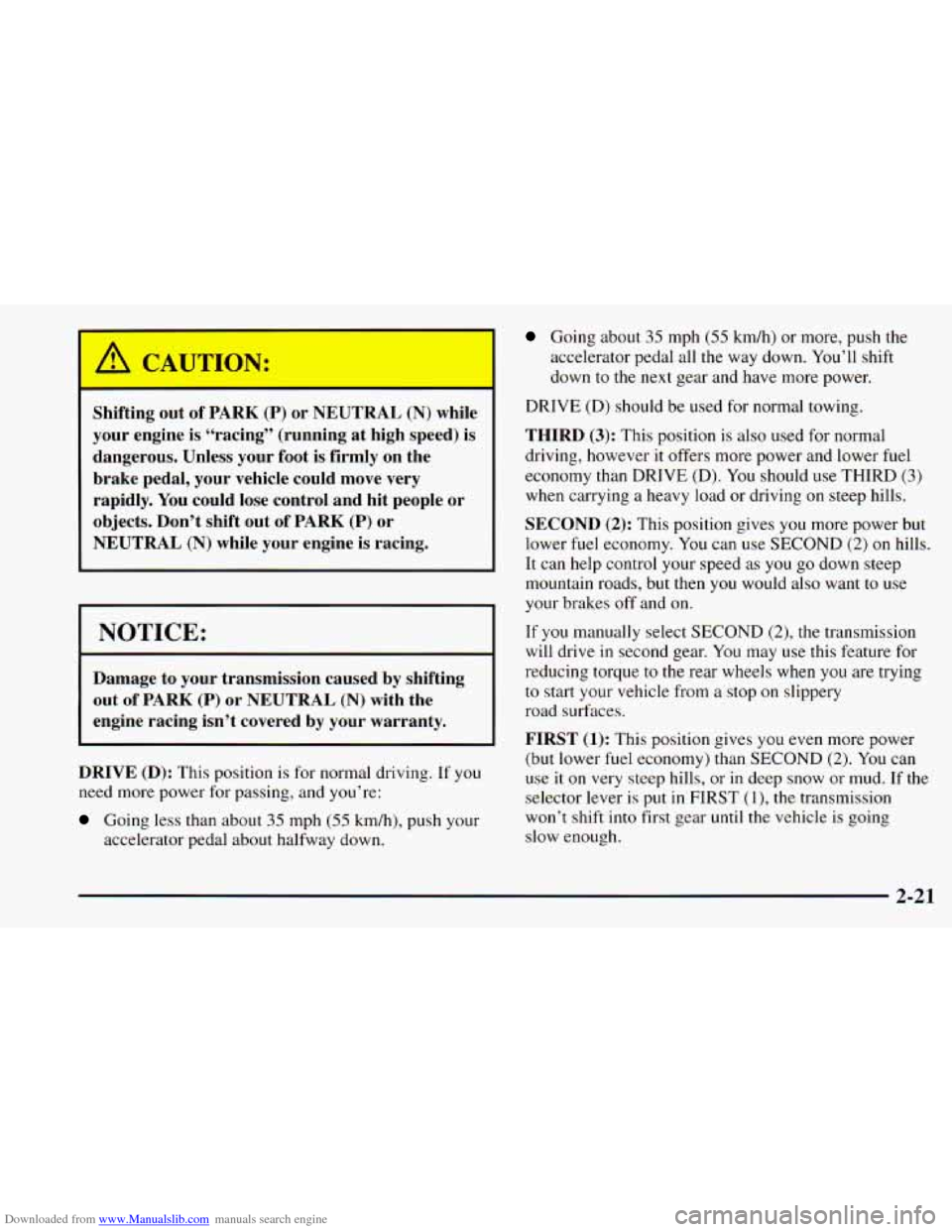
Downloaded from www.Manualslib.com manuals search engine -
A CAUTION:
--
Shifting out of PARK (P) or NEUTRAL (N) while
your engine is “racing” (running at high speed) is
dangerous. Unless your foot is firmly on the
brake pedal, your vehicle could move very
rapidly. You could lose control and hit people or
objects. Don’t shift out
of PARK (P) or
NEUTRAL
(N) while your engine is racing.
NOTICE:
Damage to your transmission caused by shifting
out
of PARK (P) or NEUTRAL (N) with the
engine racing isn’t covered by your warranty.
DRIVE (D): This position is for normal driving. If you
need more power for passing, and you’re:
Going less than about 35 mph (55 km/h), push your
accelerator pedal about halfway down.
Going about 35 mph (55 km/h) or more, push the
accelerator pedal all the way down. You’ll shift
down to the next gear and have more power.
DRIVE (D) should be used for normal towing.
THIRD
(3): This position is also used for normal
driving, however it offers more power and lower fuel
economy than DRIVE (D). You should use THIRD
(3)
when carrying a heavy load or driving on steep hills.
SECOND
(2): This position gives you more power but
lower
fuel economy. You can use SECOND (2) on hills.
It can help control your speed as
you go down steep
mountain roads, but then
you would also want to use
your brakes off and
on.
If you manually select SECOND (2), the transmission
will drive
in second gear. You may use this feature for
reducing torque to the
rear wheels when you are trying
to start your vehicle from a stop on slippery
road surfaces.
FIRST
(1): This position gives you even more power
(but lower fuel economy) than SECOND
(2). You can
use it on very steep hills, or in deep snow or mud. If the
selector lever is put in FIRST
(l), the transmission
won’t shift into first gear until the vehicle is going
slow enough.
2-21
Page 255 of 414
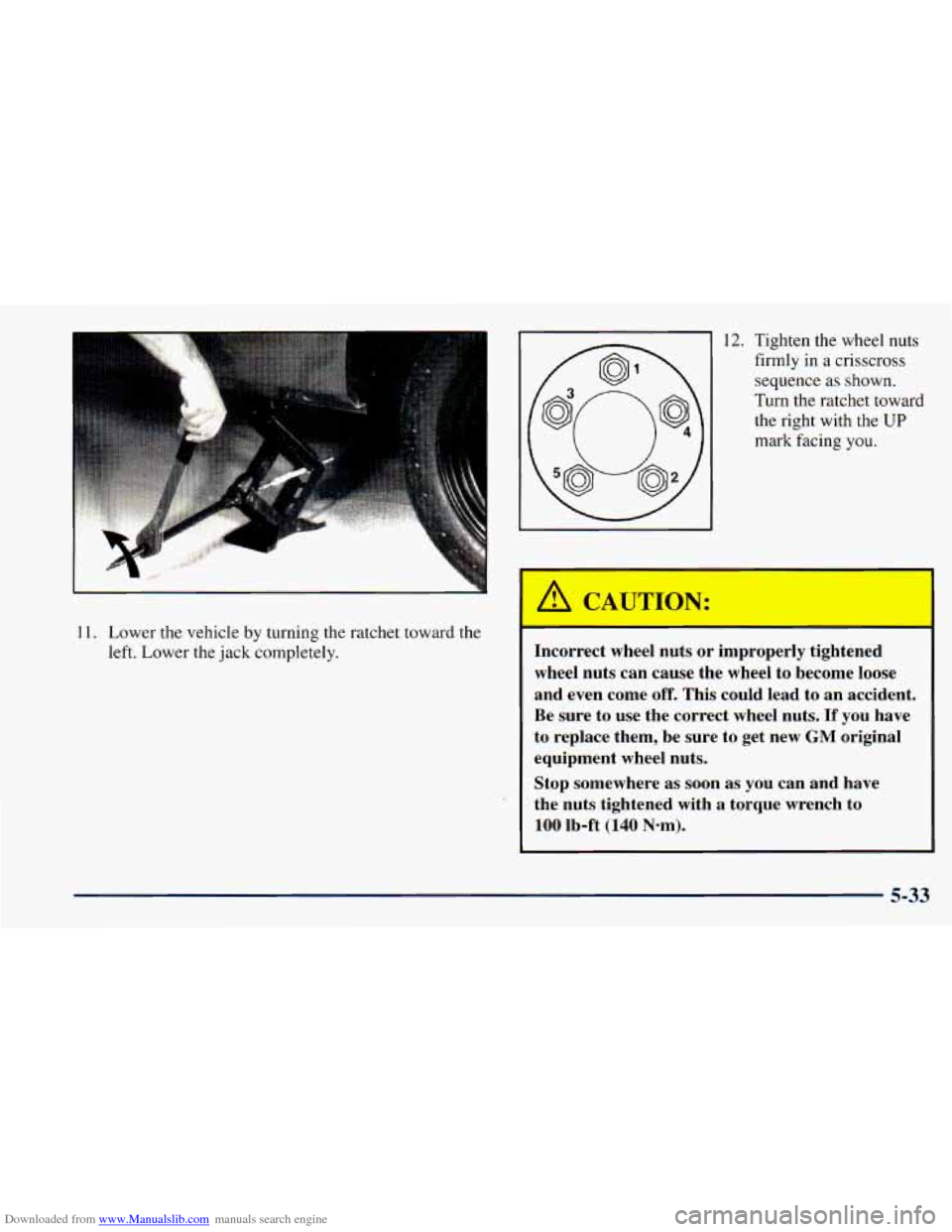
Downloaded from www.Manualslib.com manuals search engine 11. Lower the vehicle by turning the ratchet toward the
left. Lower the jack completely.
12. Tighten the wheel nuts
firmly in a crisscross
sequence as shown.
Turn the ratchet toward the right with the
UP
mark facing you.
A CAUTION:
___ -- I
In1 *rect lee1 nuts or improperly tightened
wheel nuts can cause the wheel to become loose
and even come
off. This could lead to an accident.
Be sure to use the correct wheel nuts. If you have
to replace them, be
sure to get new GM original
equipment wheel nuts.
Stop somewhere
as soon as you can and have
the nuts tightened with
a torque wrench to
100 lb-ft (140 N-m).
5-33
Page 256 of 414
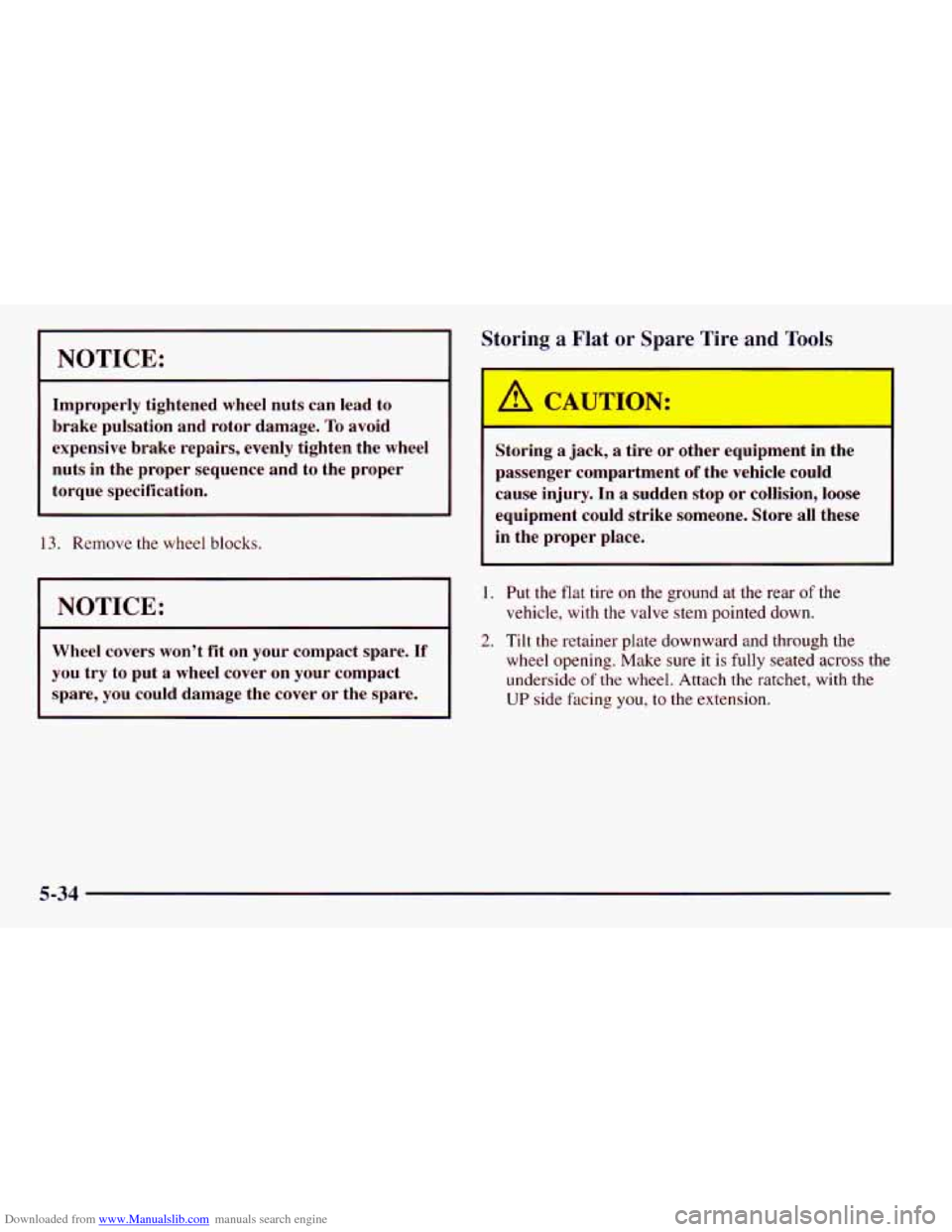
Downloaded from www.Manualslib.com manuals search engine NOTICE:
Improperly tightened wheel nuts can lead to
brake pulsation and rotor damage.
To avoid
expensive brake repairs, evenly tighten the wheel
nuts in the proper sequence and to the proper
torque specification.
13. Remove the wheel blocks.
I NOTICE:
Wheel covers won’t fit on your compact spare. If
you try to put a wheel cover on your compact
spare, you could damage the cover or the spare.
Storing a Flat or Spare Tire and Tools
I
A CdJTdN:
Storing a jack, a tire or other equipment in the
passenger compartment
of the vehicle could
cause injury. In a sudden stop or collision, loose
equipment could strike someone. Store all these
in the proper place.
1. Put the flat tire on the ground at the rear of the
vehicle, with the valve stem pointed down.
2. Tilt the retainer plate downward and through the
wheel opening. Make sure it is fully seated across the
underside
of the wheel. Attach the ratchet, with the
UP side facing you, to the extension.
5-34
Page 296 of 414
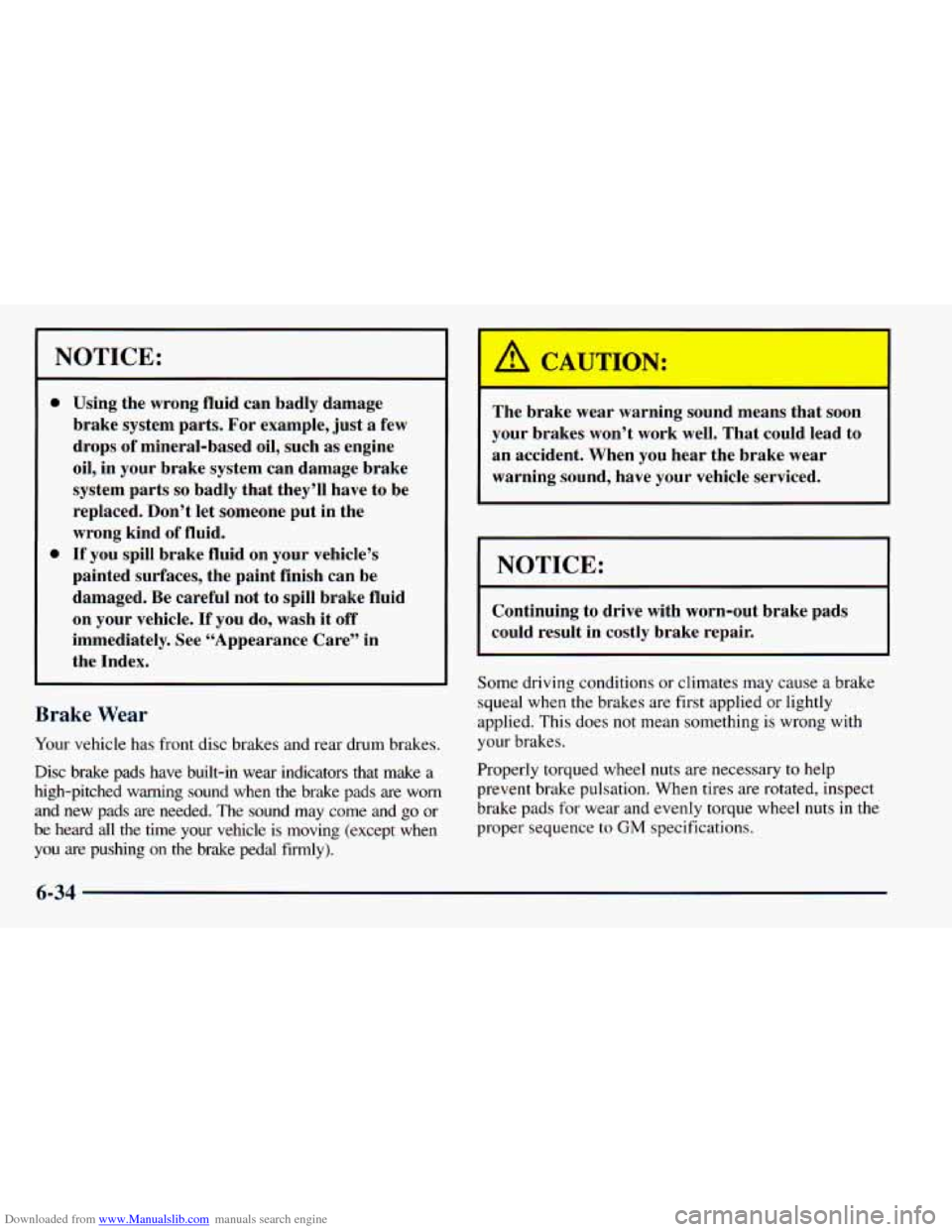
Downloaded from www.Manualslib.com manuals search engine Using the wrong fluid can badly damage
brake system parts. For example, just a few
drops of mineral-based oil, such as engine
oil, in your brake system can damage brake
system parts
so badly that they’ll have to be
replaced. Don’t let someone put in the
wrong kind of fluid.
If
you spill brake fluid on your vehicle’s
painted surfaces, the paint finish can be
damaged. Be careful not to spill brake fluid
on your vehicle. If you do, wash it off
immediately. See “Appearance Care” in
the Index.
Brake Wear
Your vehicle has front disc brakes and rear drum brakes.
Disc brake pads have built-in wear indicators that make a
high-pitched warning sound when the brake pads are
worn
and new pads are needed. The sound may come and go or
be heard all the time your vehicle is moving (except when
you are pushing on the brake pedal firmly).
A CAUTION:
The brake wear warning sound means that soon
your brakes won’t work well. That could lead to
an accident. When you hear the brake wear
warning sound, have your vehicle serviced.
I NOTICE:
Continuing to drive with worn-out brake pads
could result in costly brake repair.
Some driving conditions or climates
may ca---e a brake
squeal when the brakes are first applied
or llgntly
applied. This does not mean something is wrong with
your brakes.
Properly torqued wheel nuts are necessary to help
prevent brake pulsation. When tires are rotated, inspect
brake pads for wear and evenly torque wheel nuts in the
proper sequence
to GM specifications.
6-34
Page 307 of 414
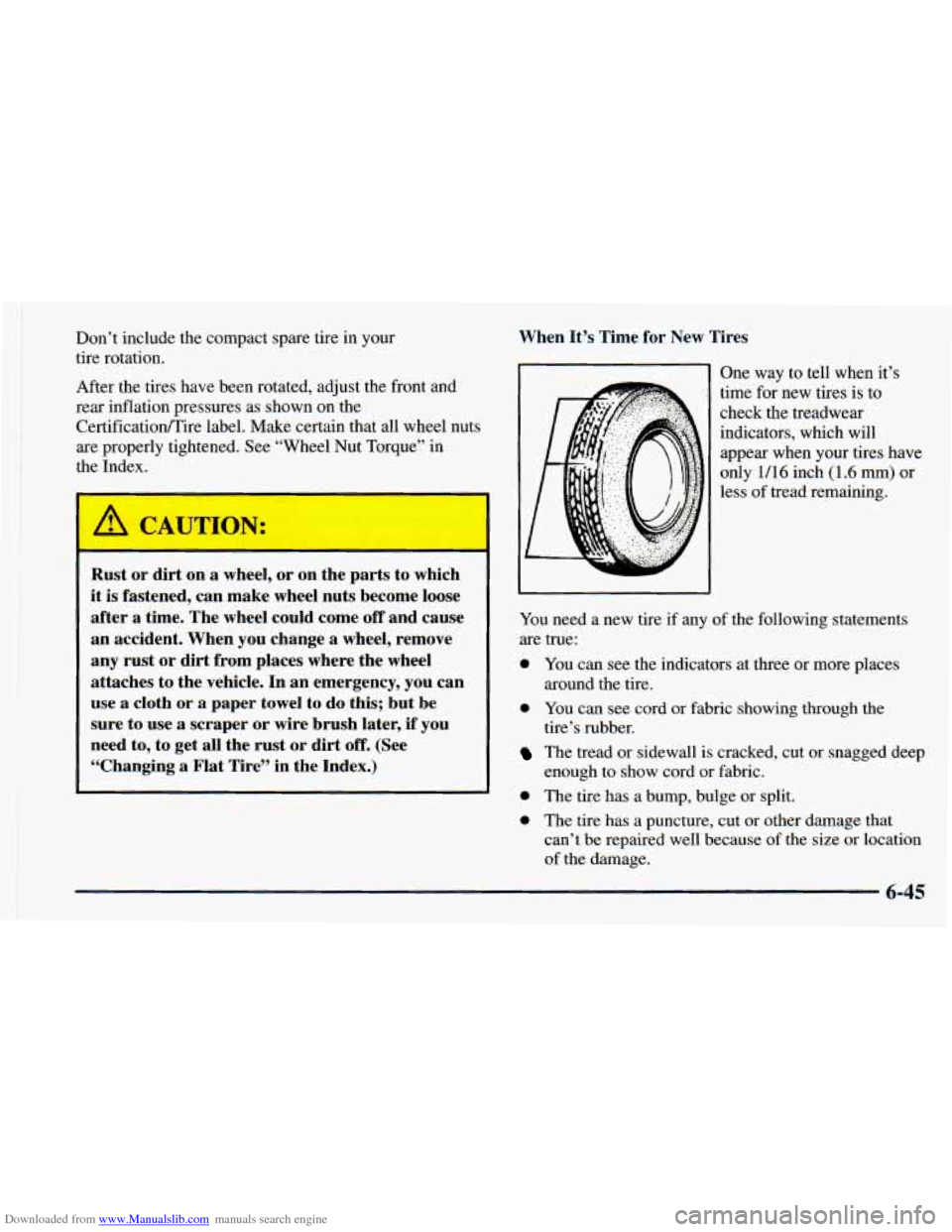
Downloaded from www.Manualslib.com manuals search engine I
Don’t include the compact spare tire in your
tire rotation.
After the tires have been rotated, adjust the front and
rear inflation pressures as shown on the
Certificationire label. Make certain that all wheel nuts
are properly tightened. See “Wheel Nut Torque” in
the Index.
Rust or dirt on a wheel, or on the parts to which
it
is fastened, can make wheel nuts become loose
after
a time. The wheel could come off and cause
an accident. When you change
a wheel, remove
any rust or dirt from places where the wheel
attaches to the vehicle.
In an emergency, you can
use
a cloth or a paper towel to do this; but be
sure to use
a scraper or wire brush later, if you
need to, to get all the rust or dirt
off. (See
“Changing
a Flat Tire” in the Index.) When
It’s Time for New Tires
One way to tell when it’s
time for new tires is to
check the treadwear
indicators, which will
appear when your tires have
only
1/16 inch (1.6 mm) or
less of tread remaining.
You need a new tire if any of the following statements
are true:
0 You can see the indicators at three or more places
around the tire.
0 YOU can see cord or fabric showing through the
tire’s rubber.
The tread or sidewall is cracked, cut or snagged deep
enough to show cord or fabric.
0 The tire has a bump, bulge or split.
0 The tire has a puncture, cut or other damage that
can’t be repaired well because of the size or location
of the damage.
6-45
Page 329 of 414
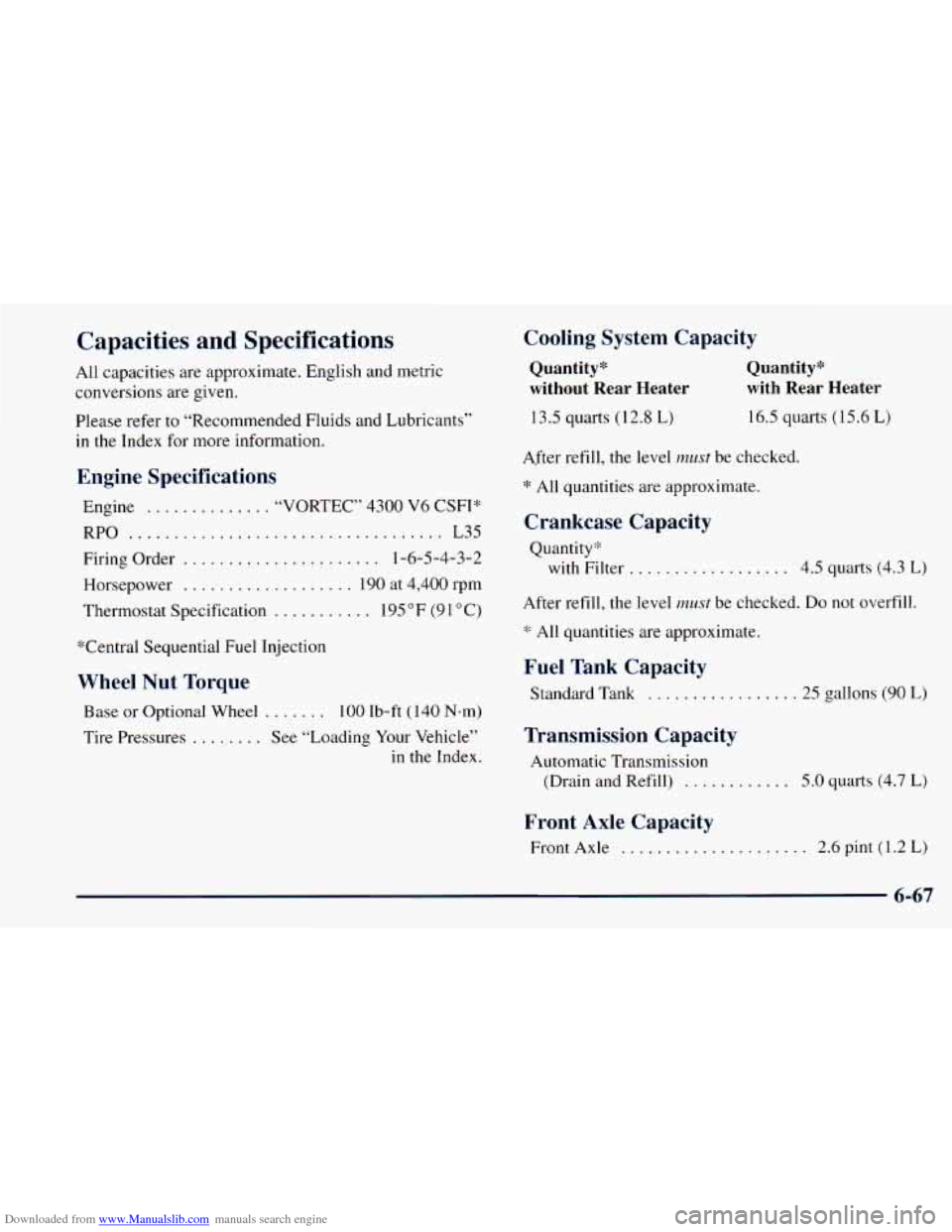
Downloaded from www.Manualslib.com manuals search engine Capacities and Specifications
All capacities are approximate. English and metric
conversions are given.
Please refer to “Recommended Fluids and Lubricants”
in the Index for more information.
Engine Specifications
Engine .............. “VORTEC” 4300 V6 CSFI*
RPO
................................. L35
Firing Order
...................... 1-6-5-4-3-2
Thermostat Specification
........... 195 OF (9 1 O C)
Horsepower
................... 190 at
4,400 rpm
*Central Sequential
Fuel Injection
Wheel Nut Torque
Tire Pressures ........ See “Loading Your Vehicle”
Base
or Optional Wheel ....... 100 lb-ft
(140 N-m)
in the Index.
Cooling System Capacity
Quantity” Quantity”
without Rear Heater with Rear Heater
13.5 quarts (12.8 L) 16.5 quarts (15.6 L)
After refill, the level
must be checked,
* All quantities are approximate.
Crankcase Capacity
Quantity”
with Filter
..... ........... 4.5 quarts (4.3 L)
After refill, the level
must be checked. Do not overfill.
* All quantities are approximate.
Fuel Tank Capacity
Standard Tank ................ .25 gallons (90 L)
Transmission Capacity
Automatic Transmission
(Drain and Refill)
............ 5.0 quarts (4.7 L)
Front Axle Capacity
Front Axle .......... . . 2.6 pint (1.2 L)
6-67
Page 407 of 414
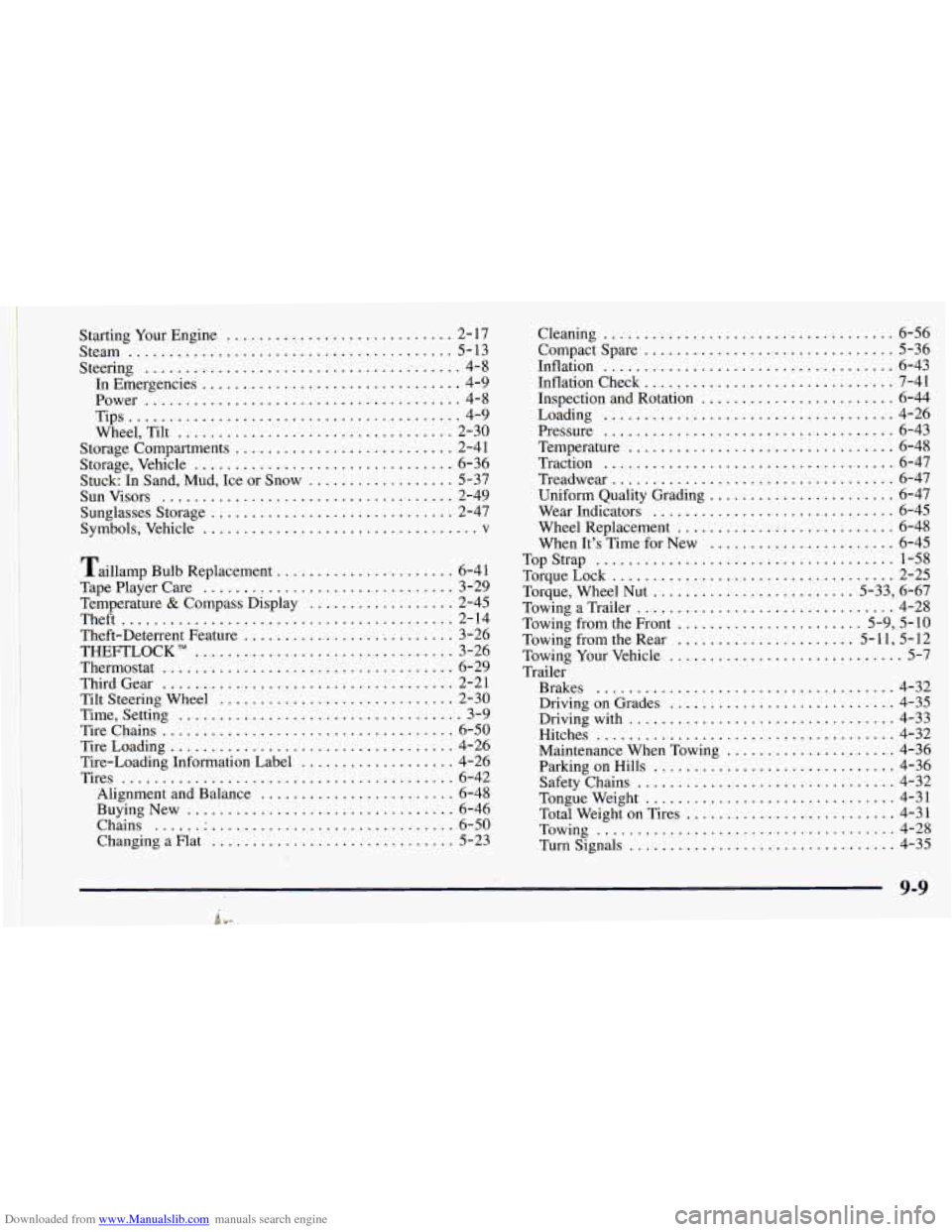
Downloaded from www.Manualslib.com manuals search engine Starting Your Engine ............................ 2-17
Steam
........................................ 5-13
Steering ....................................... 4-8
In Emergencies
................................ 4-9
Power
....................................... 4-8
Tips
......................................... 4-9
Wheel, Tilt
.................................. 2-30
Storage Compartments
........................... 2-41
Storage, Vehicle
................................ 6-36
Stuck: In Sand, Mud, Ice or Snow
.................. 5-37
Sunvisors
.................................... 2-49
Sunglasses Storage
.............................. 2-47
Symbols, Vehicle
.................................. v
Taillamp Bulb Replacement ...................... 6-41
TapePlayerCare
............................... 3-29
Temperature
& Compass Display .................. 2-45
Theft
......................................... 2-14
Theft-Deterrent Feature
.......................... 3-26
THEFTLOCK"
................................ 3-26
Thermostat
.................................... 6-29
Third Gear
...... : ............................. 2-21
Tilt Steering Wheel
............................. 2-30
Time, Setting ................................... 3-9
Tirechains
.................................... 6-50
TireLoading
................................... 4-26
Tire-Loading Information Label
................... 4-26
Tires
.......................................... 6-42
Alignment and Balance
........................ 6-48
BuyingNew
................................. 6-46
Chains
..................................... 6-50
ChangingaFlat
.............................. 5-23 Cleaning
................................ 6-56
Compact Spare
............................... 5-36
Inflation
.................................... 6-43
Inflation Check
............................... 7-41
Inspection and Rotation
........................ 6-44
Loading
.................................... 4-26
Pressure
.................................... 6-43
Temperature
................................. 6-48
Traction
.................................... 6-47
Treadwear
................................... 6-47
Uniform Quality Grading
....................... 6-47
Wear Indicators
.............................. 6-45
Wheel Replacement
........................... 6-48
When It's Time for New
....................... 6-45
Top Strap
..................................... 1-58
Torque, Wheel Nut
......................... 5-33, 6-67
Towing a Trailer
................................ 4-28
Towing from the Front
....................... 5-9, 5-10
Towing from the Rear
...................... 5-1 1, 5-12
Towing Your Vehicle
............................. 5-7
Trailer Brakes
..................................... 4-32
Driving on Grades
............................ 4-35
Driving with
................................. 4-33
Hitches
..................................... 4-32
Maintenance When Towing
..................... 4-36
Parking on Hills
.............................. 4-36
Safety Chains
................................ 4-32
Tongueweight
............................... 4-31
Total Weight on Tires
.......................... 4-31
Towing ..................................... 4-28
Turnsignals
................................. 4-35
TorqueLock
................................... 2-25
9-9